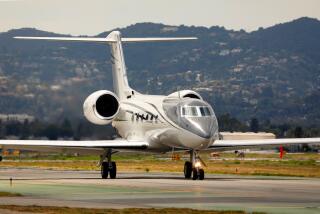Flight Attendants Lobby for Cleaner Air
- Share via
One of the perennial concerns of people who fly frequently has been the quality of the air they breathe in flight.
Fifteen years ago, most complaints centered on discomfort caused by dry air. Five years ago, the primary complaint was from breathing secondhand smoke, which led Congress in 1990 to ban smoking on all flights shorter than six hours.
Recently, however, concerns have focused on environmental hazards, ranging from air pollutants to the risk of getting a communicable illness.
In testimony before Congress last week, Federal Aviation Administration officials supported recent studies showing that cabin air is healthful to breathe. However, the Assn. of Flight Attendants, a 33,000 member union, continues to press Congress for legislation to set higher standards for fresh air in planes.
The union argues that fresh air contains fewer contaminants, including airborne viruses and bacteria, than does recirculated air. In addition, the group believes that by changing the air in the plane more frequently, the risk of disease-causing organisms or fumes being inhaled by passengers will be reduced.
*
Toward that end, Reps. Jerrold Nadler (D-N.Y.) and Peter A. DeFazio (D-Ore.) have introduced a bill that would set a standard for the amount of fresh air reaching passengers and crew in the cabin, as well as establish a toll-free phone number for reporting air quality problems.
“There are currently no federal minimum standards for the amount of fresh air” in aircraft cabins, said Chris Witkowski, a spokesman for the Assn. of Flight Attendants. However, there are standards for the cockpit, where pilots are required to be alert at all times, he said.
The increased attention to air quality is due in part to a change in the way newer aircraft ventilate their cabins, said David Stempler, executive director of the International Airline Passengers Assn., a Washington-based group that represents 110,000 passengers. Aircraft built at least 15 years ago circulate 100% fresh air throughout the cabin, whereas newer ones use a combination of fresh and recycled cabin air.
This change, along with a reduction in the number of times the air in the cabin is replaced with fresh air, has raised concerns that the level of contaminants in aircraft air is higher than it was before.
*
The Assn. of Flight Attendants said anecdotal evidence of crew members’ symptoms--such as dizziness, headaches, nausea and feelings of disorientation--has been increasing, although the union has not officially tracked the number of complaints.
Because of such complaints, the FAA and the airline industry have mounted several studies over the past five years to look at air quality on aircraft.
*
Most recently, for example, the Air Transport Assn., a Washington-based trade organization that represents airlines, released the results of its “Airline Cabin Air Quality Study.” The study, conducted by independent testing agency Consolidated Safety Services Inc., sampled air on 35 flights of various lengths on eight major airlines.
Sampling took place on four types of aircraft, both newer and older models. The tests measured carbon dioxide, temperature, relative humidity, noise, volatile organic compounds and particulates. The company also took samples to identify bacterial and fungal contaminants.
Results showed that “levels of contaminants found in airline cabins are not likely to cause adverse health effects” and that “both generations of aircraft exceed the requirements for maintaining a healthy air quality environment.”
*
In addition, the study found that levels of carbon dioxide, a byproduct of breathing that can cause symptoms such as lethargy, dizziness and rapid heart rate at high concentrations, were lower than those found in other indoor settings, such as shopping malls or office buildings.
In his recent testimony before Congress, Jon Jordan, the federal air surgeon for the FAA, reviewed results of that study and two other reports--a 1989 study conducted for the FAA and the Department of Transportation and a 1991 study conducted by the National Institutes of Occupational Safety and Health. They also found that levels of airborne contaminants and other pollutants were beneath federal guidelines.
The FAA therefore believes that current ventilation systems maintain healthful air on planes, said Hank Verbais, a spokesman for the FAA’s Western Pacific Region.
Still, the perception that the air in the enclosed space of an airliner contains unhealthful levels of particulates and other compounds remains. The Assn. of Flight Attendants believes it is a safety issue, because the safety of passengers depends on flight attendants functioning without impairment in an emergency. And the FAA continues to get calls from concerned passengers. The Airline Passengers Assn., however, said it is no longer a major issue for its members.
*
A more alarming issue for passengers who fly overseas is the practice at some international airports of using pesticides to decontaminate planes, Stempler said. Fear of introducing insects that could damage crops is the motivation, but the practice, which the Airline Passengers Assn. is currently investigating, has raised health concerns among its members.
More to Read
Inside the business of entertainment
The Wide Shot brings you news, analysis and insights on everything from streaming wars to production — and what it all means for the future.
You may occasionally receive promotional content from the Los Angeles Times.










